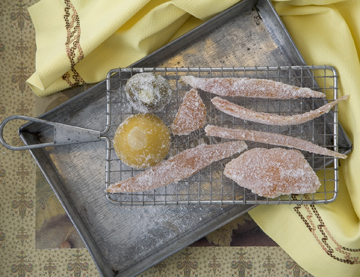Some know it as the season of light. Others, the season of giving. But for many of you, it’s the season of citrus and fruitcake. You’re probably already compiling ingredient spreadsheets and collecting addresses for the lucky ducks who will get a family fruitcake, right? But what’s that you say? You’re not making the candied citrus peels from scratch? Well, why not?!
Okay, so you might be saying, MaryJane, I’ll be darned if I’m going to give myself one extra project when I can just buy them at the store. But have another look at that candied peel lining store shelves right around now. Doesn’t it look a little bright? Doesn’t it seem a little soggy? Doesn’t it taste a bit … fake? In a blindfolded test, I’ll bet you’d be hard-pressed to distinguish it from a gummy bear …
There are reasons for this—look no further than the ingredients list. HFCS, red and yellow dyes, chemical preservatives you haven’t a snowball’s chance in a sauna of pronouncing, and artificial flavors. Little wonder so many of us make fun of fruitcake. Little wonder it’s often relegated to doorstop status.
But homemade candied peels? They’re an altogether different story. These vibrant ribbons of citrus glisten like jewels in their shiny syrup cases and “glitter” exteriors. Their sugar coats catch the light so beautifully you’d think these darlings belonged in a Tiffany box. And the taste is true citrus, through and through. Still tangy, sour, and bold, but now softer and sweeter. They’re a treasure on the tongue and a pleasure to crunch between your teeth. And in a homemade fruitcake accented with rum-soaked raisins, currants, and cherries? Heaven.
But fruitcake isn’t the only good use for candied peels. Dip them in chocolate, sprinkle them on custard, or eat ’em whole like you would dried fruit. Put out a bowl for guests, chop some over ice cream or into a quick bread, or make up tiny ribbon-wrapped jars to give as gifts. Use it like a breath “mint,” or perch it on your teacup rim for that little something extra. Press pieces into the tops of shortbread cookies before baking, mix some into brownie batter, or stuff them into the centers of homemade truffles.
Here’s a simple recipe for candied peel to get you started, but why not turn all your peels into citrus candy year-round? Winter’s upon us, meaning big, fat, juicy citrus fruits, even minneolas and clementines are showing up on our doorsteps as gifts. Why waste the peels? How about candied lime peel over flan to end a delicious Mexican meal? Candied grapefruit peel in a fruit salad, alongside cinnamon rolls for brunch? Candied clementine peel chopped and sprinkled over some cranberry sauce? Meyer lemon candy resting on the rim of a double espresso to celebrate a successful shopping trip? Or muddle some candied key lime peel into an oh-yes-I-do-remember-that-one-vacation mojito.

Save up about 4 cups of peels (accumulated from just a couple of days), storing them in your refrigerator in a covered container. This includes lime and lemon rinds leftover from juicing. Simply slice or cut the peels into strips using a knife or a clean pair of scissors. Remove as much of the white pith as you can, but don’t go overboard.
CANDIED CITRUS PEEL
4 cups citrus peels (since we’re using the peel, organic REALLY counts here)
3 1/2 cups sugar, divided
Bring three cups water to boil in a blancher. Find two more pots that will also hold the blancher’s colander and put them to boil also. Blanch the sliced peels for 5 minutes. Drain and rinse. Repeat two more times for a total of three blanchings. (This removes any bitterness.)
Mix 2 1/2 cups sugar and 2 cups water in a small saucepan. Cook over low heat, stirring occasionally, until the sugar dissolves. Raise the heat and bring mixture to a boil. Add the peels and reduce the heat to low. Simmer for 60 minutes, stirring occasionally. Drain the peels. You’ll have some leftover citrus-infused sugar syrup. Drizzle it over waffles or a bowl of ice cream or use some to flavor a cocktail.
Place remaining 1 cup sugar into a wide, shallow bowl. Use a slotted spoon to transfer the drained peels into the sugar, tossing them around and coating each peel individually. Spread them on a rack placed over a cookie sheet for catching drips. Let dry for at least a day. Pack in an airtight container and store in your refrigerator. I dare you NOT to eat them all before you’ve made your fruitcake.





















































My Mom used to make candied citrus peel and I remember it being delicious. Thanks for reminding me and providing a recipe. With my orange tree out front hanging to the ground with oranges, candied peel is a neat way to make something s sweet that is not a cookie.
Oh, now I can’t wait to buy some oranges!. I love candied orange peel!
This sounds so tasty! My mother never put commercial candied peels in her fruitcakes because it tasted bitter and did not add to the flavor, so I must try this.
Since 1965 instead of fruitcakes we have made fruitcake cookies because it is easier (no brown paper to cut and fit to our rectangular pans and butter) and tastes as good or better. Our recipe uses candied red and green cherries (any idea how to make those, maybe similar to the candied peel?), red and green candied pineapple, chopped dates, and Meyers dark rum. They have the colors of Christmas and taste delicious with hot tea or coffee. Mary Beth